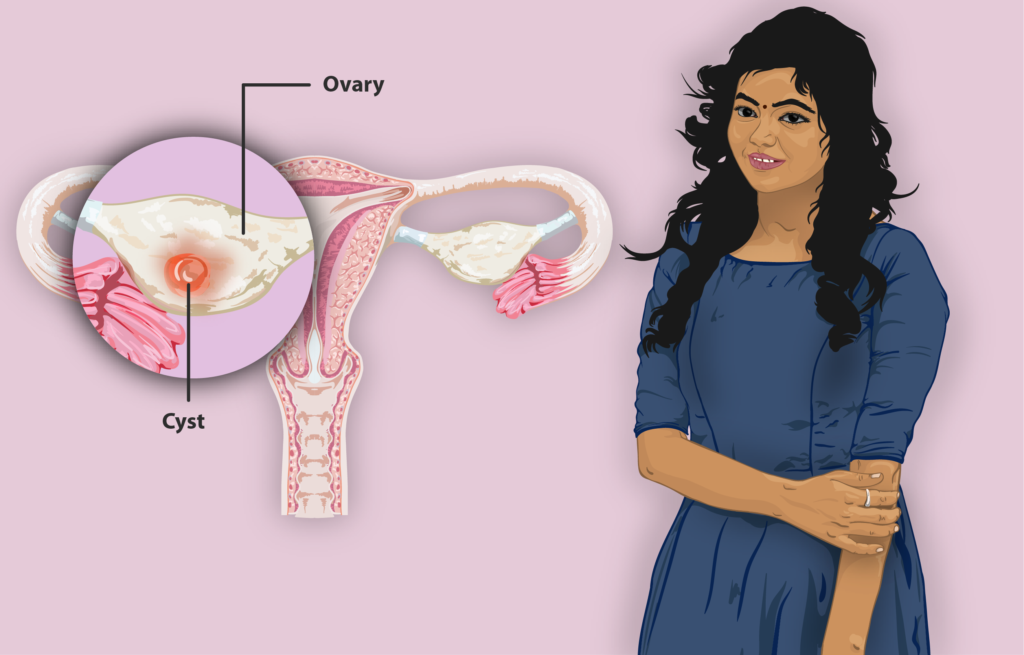Dr. Vivek Salunke & Dr. Shinjini Pande are one of the best Laparoscopic Surgeon for Ovarian Cyst treatment surgeon In Mumbai. More then 35 years of combine experience in laparoscopy. At our treatment center we offer total care of the patient and have state of the art equipment like 3D laparoscopy.
Treatment, if needed at all depends on the following factors:
- Size of the cyst.
- Type of the cyst
- Symptoms experienced
LAPAROSCOPY :
Most types of cysts can be removed using laparoscopy. A laparoscope (a small, lighted microscope) is passed into your abdomen through minimal incisions. This is done so that the surgeon can see the internal organs. A laparoscopy is preferred to laparotomy since the recovery time is lesser in the former.
Please call us or provide us your details, along with a description of your problem to get a better idea of the Ovarian Cyst Treatment.
The causes of ovarian cysts depend on their classification:
Functional Cysts
-
Follicular ovarian cysts:
They are the most common type of cysts. The egg produced by ovaries moves into the uterus (womb). This egg grows in the follicle, which protects the egg with help of fluids. Normally when the egg is released, the follicle should burst but in some cases, the fluid contained by the follicle is not shredded even after releasing the egg, or in some cases the follicle does not release the egg itself. As a result such a follicle swells with fluid, and results in the formation of follicular ovarian cyst.
Such cysts are not as common as follicular cysts. They are formed when corpus luteum is filled with blood. Corpus luteum is a tissue which is left behind after the egg is released.
Pathological cysts
- Dermoid cysts (cystic teratomas):
Dermoid cysts are the most common type of pathological cysts for women under the age of 30. It forms due to a totipotential germ cell (a primary oocyte). A totipotential germ cell is a cell that can form all orders of cells that are required to form mature tissues. Dermoid cysts contain bone, skin, hair and sometimes even other tissues (e.g. teeth).
Cyst adenomas are more common to postmenopausal women. Such ovarian cysts develop from cells which cover the outer part of the ovaries. Since they are not inside the ovary they have potential to grow considerably large.
The two major risk factors to be considered are endometriosis and polycystic ovary syndrome.
In this disease the tissue (called as Endometrium) which normally lines the inside of the womb/uterus and which is normally shed off with blood during periods, grows outside the uterus and is seen involving ovaries and many other organs. Such types of cysts are very painful.
Polycystic Ovary Syndrome:
In this condition the follicles in which an egg normally grows and matures does not open and results in the formation of cysts.
Ovarian Cyst Symptoms related to menstrual cycle & sexual activity:
- Pain during sexual intercourse, especially during deep penetration.
- Irregular periods.
- Chronic low back or pelvic pain during the menstrual cycle.
- Vaginal pain or spotty bleeding from the vagina.
- Infertility
Ovarian Cyst Symptoms related to digestion & abdomen
- Indigestion
- Pain in the pelvic or lower abdomen area.
- Pain during urination or bowel movement.
- Nausea or vomiting.
- Problems in having bowel movements & feeling pressure to have a bowel movement.
- Abdominal distension.
- Bloating & feeling of abdominal fullness.
- Abdominal tenderness.
Others
- A feeling of lower abdominal/pelvic pressure or fullness.
- Problems controlling urination.
The diagnosis of cysts is done on the basis of its size and its composition, i.e. does it contain only fluids or a mixture of fluids and solids. In the case of the former the cysts are likely to be benign, while in the case of latter, further tests may be required to determine the result. Following are different procedures used to ascertain the presence and nature of the cysts:
Pregnancy test:
A pregnancy test can be useful to ascertain cysts caused due do corpus luteum.
Pelvic ultrasound:
In this procedure the doctor uses ultra sound waves to produce an image of the cyst if it is present. With the help of this procedure the doctor can determine if a cyst is present at all and if it is present the size, location and its composition.
Laparoscopy:
In laparoscopy the surgeons uses a laparoscope – a small, lighted instrument which is inserted through incisions in order to ascertain the cyst.
CA 125 blood test:
In order to diagnose if the cyst is cancerous the doctor may use the CA 125 blood test. CA 125 is a protein, which often found in high numbers in women with ovarian cancer.
Treatment, if needed at all depends on the following factors:
- Size of the cyst.
- Type of the cyst
- Symptoms experienced
The following options exist for treatment:
Wait and watch :
If your symptoms are not severe and do not affect your daily activities, then you can wait for a few months to see if the cyst goes away. To do the same you can schedule an ultrasound few months after your initial diagnosis.
Surgery:
If the symptoms are severe, surgery should be pursued. There are two options in terms of surgeries the first one is laparoscopy and the other is laparotomy.
Laparoscopy :
Most types of cysts can be removed using laparoscopy. A laparoscope (a small, lighted microscope) is passed into your abdomen through minimal incisions. This is done so that the surgeon can see the internal organs. A laparoscopy is preferred to laparotomy since the recovery time is lesser in the former.
Laparotomy :
If the cyst is extremely large or cancerous in nature then laparotomy is the preferred procedure. In this case the incisions are larger than those in case of laparoscopy.
